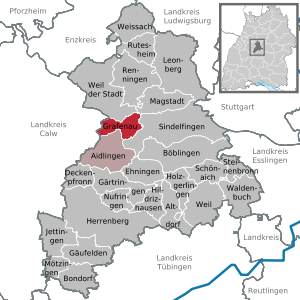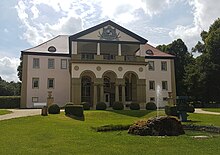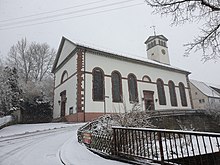Grafenau (Württemberg)
| coat of arms | Germany map | |
|---|---|---|

|
Coordinates: 48 ° 43 ' N , 8 ° 54' E |
|
| Basic data | ||
| State : | Baden-Württemberg | |
| Administrative region : | Stuttgart | |
| County : | Boeblingen | |
| Height : | 402 m above sea level NHN | |
| Area : | 13.05 km 2 | |
| Residents: | 6747 (December 31, 2018) | |
| Population density : | 517 inhabitants per km 2 | |
| Postal code : | 71120 | |
| Area code : | 07033 | |
| License plate : | BB, LEO | |
| Community key : | 08 1 15 054 | |
| Community structure: | 2 districts | |
| Address of the municipal administration: |
Hofstetten 12 71120 Grafenau |
|
| Website : | ||
| Mayor : | Martin Thuringian | |
| Location of the municipality of Grafenau in the district of Böblingen | ||
Grafenau is a municipality in the Boeblingen district near the cities of Sindelfingen , Weil der Stadt and Calw .
geography
Waters
The rivers Schwippe and Würm and the Altbach flow through Grafenau.
Community structure
The community Grafenau consists of the formerly independent communities Dätzingen and Döffingen. The village of Dätzingen belongs to the former municipality of Dätzingen. The former municipality of Döffingen includes the village of Döffingen and the places Burschelberg, Kapellenberg and Wenninger Höfe as well as the lost villages of Hofstätten, Mietersheim, Welbingen, Stegmühle (probably merged into Burschelberg).
history
Until the parish merger
Both Döffingen and Dätzingen were first mentioned in a document in 1075. Since September 1, 1972, Döffingen and Dätzingen have been part of the Grafenau community.
Dätzingen
Originally the place belonged to the Counts of Fürstenberg . In the 13th century, the entire place came into the possession of the Order of St. John / Maltese . Dätzingen formed from 1263 a separate Coming and belonged to the Grand Priory of Germany Johanniter / Order of Malta, based in Heitersheim. The Reformation did not take place here. In 1806 Dätzingen came to the Kingdom of Württemberg and was assigned to the Oberamt Böblingen .
In 1850 Dätzingen had five Protestant and 640 Catholic residents who lived and worked in 86 main buildings and 43 auxiliary buildings.
Döffingen
Döffingen was under the Count Palatine of Tübingen , but fell to Württemberg in the 14th century . In 1388 the great battle of Döffingen took place here (see also Ulrichstein ), which brought the decisive victory of the sovereign princes under Eberhard II of Württemberg against the free imperial cities and led to the peace of Eger . Almost all of Döffingen was destroyed by a great fire on September 8, 1634 - but it was quickly rebuilt.
Döffingen already belonged to the office and later Oberamt Böblingen in the old Württemberg period. In 1850 Döffingen had 1,194 Protestant and 13 Catholic residents who lived and worked in 147 main and 124 outbuildings.
Administrative affiliation
During the district reform during the Nazi era in Württemberg , Döffingen and Dätzingen became part of the Boeblingen district in 1938 . In 1945, both places became part of the American zone of occupation and thus belonged to the newly founded state of Württemberg-Baden , which became part of the current state of Baden-Württemberg in 1952.
Population development
These are population numbers according to the respective territorial status. The numbers are census results (¹) or official updates from the Baden-Württemberg State Statistical Office (only main residences).
|
|
religion
While the Order of Malta area of Dätzingen remained Catholic and the Dätzingen parish of St. Leonhard is now a pastoral care unit with the parish of St. Peter u. Paul in Weil forms the town and is assigned to the dean's office in Böblingen , the Reformation was introduced in Old Württemberg and thus also in Döffingen in the 16th century . The Protestant parish belongs to the church district of Böblingen (see Protestant parish Döffingen ) of the Evangelical Regional Church . Nowadays there is also a New Apostolic congregation in town.
politics
Municipal council
In Grafenau, the municipal council is elected according to the procedure of the false sub-district election. The number of local councils can change due to overhang mandates . The municipal council in Grafenau has 19 members after the last election (2014: 16). The local elections on May 26, 2019 led to the following final result. The municipal council consists of the elected voluntary councilors and the mayor as chairman. The mayor is entitled to vote in the municipal council.
| Parties and constituencies |
% 2019 |
Seats 2019 |
% 2014 |
Seats 2014 |
||
| CDU | Christian Democratic Union of Germany | 22.24 | 4th | 33.83 | 6th | |
| FW | Free voters Grafenau | 29.95 | 6th | 32.66 | 5 | |
| GREEN | Alliance 90 / The Greens | 18.86 | 3 | 19.83 | 3 | |
| SPD | Social Democratic Party of Germany | 12.22 | 2 | 13.67 | 2 | |
| FDP | Free Democratic Party | 8.57 | 2 | - | - | |
| Political party | The party | 8.16 | 2 | - | - | |
| total | 100.0 | 19th | 100.0 | 16 | ||
| voter turnout | 64.98% | 53.86% | ||||
mayor
From 1972 to 1996 the later honorary citizen Ewald Bien (* 1940; † 2016) was mayor of Grafenau, who was mayor of the then still independent municipality of Dätzingen from 1966 to 1972. Ewald Bien's successor in the office of mayor of Grafenau was Martin Thüringer in 1996. He was able to take up his third term in office in December 2012.
coat of arms
Blazon: In red under two diagonally crossed a golden Heuliechern a silver Johanniterkreuz.
Economy and Infrastructure
traffic
Grafenau is easily accessible via the federal highways 8 and 81 . The A 81 is about 7 km from Grafenau.
There is a bus connection with lines 763 (Böblingen-Calw) and 766 (Böblingen-Weil der Stadt) from Regiobus Stuttgart and with line 749 (Ostelsheim-Grafenau-Sindelfingen) from a private bus company. The Böblingen train station can be reached in around 15 minutes by bus.
There is a rail connection via the S1 line of the Stuttgart S-Bahn station Hulb in the direction of Stuttgart or Herrenberg or via Weil der Stadt . The closest airport is Stuttgart Airport .
Culture and sights
Monuments
- Ulrichstein , built in 1888 in memory of Crown Prince Ulrich von Württemberg, who had fallen there 500 years earlier.
building
- Maltese Castle in Dätzingen
- Evangelical Martinskirche in Döffingen with a choir tower from the 11th / 12th centuries. century
- Catholic Leonhard Church in Dätzingen in the classicism style at the beginning of the 19th century
- Kapellenbergturm , built in 1958/59 as a water tower
- Graf-Ulrich-Bau , gymnasium and festival hall built in 1936/1937 in homeland security style
societies
There are many associations in Grafenau, including the "Chorvereinigung Grafenau eV" (Choir Association Grafenau eV) (consisting of the former song wreath, which goes back to the male choir founded in 1846, and the Klangfarben), the music association, the Grafenau Chamber Orchestra and the Children's Chamber Orchestra as well as the two HCs from Döffingen and Dätzingen. From the field of sports the TSV, the tennis club. One of the youngest clubs is the 1st fools guild.
Well known beyond the borders of Grafenau is the culture circle Grafenau, founded in 1975, which organizes series of concerts and events around the Dätzinger Schloss in the fields of music, theater / exhibition and local history museum.
schools
Since Grafenau consists of two districts that used to be independent communities, there are still two independent schools. In Dätzingen, for example, there is a primary school with connected core-time care, and in Döffingen, since the school year 2012/13, there is a community school (formerly elementary and technical school), also with core-time care.
The adult education center Böblingen / Sindelfingen operates a branch in Grafenau.
The music school "Geigenschule Ziegler" has been based in Grafenau since 2007, and in 2014 it celebrated its 10th anniversary in public.
Sons and daughters of the church
- Georg von Morlok (1815–1896), born in the Dätzingen district, architect and railway engineer
- Karl Hermann von Zeller (1849–1937), born in the Döffingen district, lawyer, president of the consistory and the church government of the Evangelical Church in Württemberg
- Franz Heinkele (1881–1950), born in the Dätzingen district, Tuttling local politician
Individual evidence
- ↑ State Statistical Office Baden-Württemberg - Population by nationality and gender on December 31, 2018 (CSV file) ( help on this ).
- ^ The state of Baden-Württemberg. Official description by district and municipality. Volume III: Stuttgart District, Middle Neckar Regional Association. Kohlhammer, Stuttgart 1978, ISBN 3-17-004758-2 . Pp. 81-83
- ^ Federal Statistical Office (ed.): Historical municipality directory for the Federal Republic of Germany. Name, border and key number changes in municipalities, counties and administrative districts from May 27, 1970 to December 31, 1982 . W. Kohlhammer, Stuttgart / Mainz 1983, ISBN 3-17-003263-1 , p. 447 .
- ^ Dätzingen in the description of the Oberamt Böblingen from 1850
- ↑ a b Description of the Upper Office Böblingen - Table I.
- ^ Döffingen in the description of the Upper Office Böblingen from 1850
- ↑ Population development in Baden-Württemberg from 1871 to 2014 ( Memento of the original from September 12, 2014 in the web archive archive.today ) Info: The archive link has been inserted automatically and has not yet been checked. Please check the original and archive link according to the instructions and then remove this notice.
- ↑ Election information for the municipal data center
- ↑ Chorvereinigung Grafenau eV Accessed on November 16, 2018 .
- ^ Activities of the Grafenau cultural area. Retrieved November 18, 2018 .
- ↑ New sounds should expand the musical landscape of Grafenau , Böblinger Kreiszeitung from July 14, 2014
Web links
- Official website of the municipality
- Johanniterkommende Dätzingen in the database of monasteries in Baden-Württemberg of the Baden-Württemberg State Archives










